► Mclaren F1-beating 250mph V-max
► Just 106 Speedtails will be made
► A £1.75m, 250mph, carbonfibre dart
McLaren Special Operations (MSO) has revealed one of the last Speedtails to be built of the 106 examples that were originally planned, as production of its fastest ever road car draws to a close.
The ‘Albert’ Speedtail was commissioned by McLaren Beverly Hills, and gets its name from a 2018 prototype that was used to validate the car’s central driving position, driver ergonomics, visibility and rear-view camera positions. The Albert prototype was also the first Speedtail to be driven on public roads, albeit with front panels from a 720S.
The Albert name dates back to a line of test mules that preceded the McLaren F1 in 1992. Those were named after Albert Drive, where the F1 was designed and built in Woking.
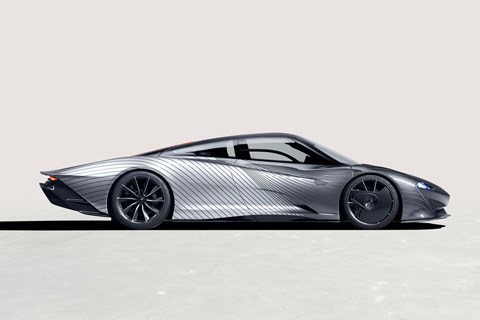
This fully-fledged Speedtail features ‘one of the most complex paint themes’ ever undertaken by MSO, which took 12 weeks to complete. This included two weeks of masking, six weeks of painting and a further four weeks to dry and assemble the finished panels.
The two-tone design comprises Magnesium Silver – the colour that the McLaren F1 was first shown in at the Monaco Grand Prix in 1992, and the Ueno Grey of the F1 GTR that won the 24 Hours of Le Mans in 1995. The printed lines reflect the optimal flow of air over the body of the car.
‘As one of the very last Speedtails to be built at the McLaren Production Centre, it was very important to us at McLaren Beverly Hills that ‘Albert’ honours the brand’s rich heritage, particularly paying tribute to the icon that is the McLaren F1,’ said the retailer’s Parris Mullins. ‘We are fortunate to have been able to procure ‘Albert’ for one of our top clients and are absolutely thrilled with the finished result.
The Albert Speedtail will make its public debut at Sunset GT – a luxury cars and coffee event held in Sunset Plaza, Los Angeles – on 8 August.
McLaren Speedtail: the full engineering story
When we first previewed McLaren’s astonishing low-drag, three-seat Speedtail, powertrain details were thin on the ground – Woking refused to even confirm that its trademark twin-turbo V8 was under that streamlined engine cover.
But now we know how the car’s 1035bhp and 848lb ft outputs break down. Thanks in part to a four-fold increase in battery power density over the P1, McLaren’s first hybrid, the Speedtail’s electric motor alone generates 309bhp and 258lb ft of torque.
The V8, running in a more friendly state of tune than it does in the more extreme Senna GTR, brings 746bhp and 590lb ft of torque to the table. (The two power figures add up to more than 1035bhp because the two power units don’t deliver their peak outputs at the same time.)
The Speedtail packages its battery low behind the passenger compartment, with the electric motor plumbed into the V8 and the compact power electronics unit up high behind the occupants’ heads, to take advantage of cooling airflow. In the nose, a wireless charger keeps the battery topped up. Unlike the P1, the Speedtail has no EV-only range. But it is lighter, and McLaren claims 0-186mph in just 12.8sec.
The electric motor uses Formula E-derived tech – a series where McLaren’s Applied offshoot supplies the batteries – and claimed the highest performance battery installation for a production road car at the time. Interestingly, McLaren counted both cooling and integration in that claim.
The battery in the Speedtail is four times more energy dense than that in the P1, and therefore capable of a 5.2kW/kg power-to-weight ratio. As you’d expect, that sort of power transfer generates a fair amount of heat, so the cells are immersed in a lightweight electrically insulative oil for fast dissipation. The increased transfers speeds make for higher thermal efficiency and repeatability – and it’s the first system of its kind seen outside of a race track.
The McLaren Speedtail costs £1.75 million and is the grandchild of the McLaren F1. It was also the first model of Woking’s Track 25 business plan.
Aero-focused streamlining
The most striking thing about the new hyper GT has to be its elongated, streamlined looks.
At 5137mm, or 17 feet in old money, the new Speedtail is more than half a metre longer than the P1 – but narrower – and every square inch is designed to minimise drag and maximise V-max.
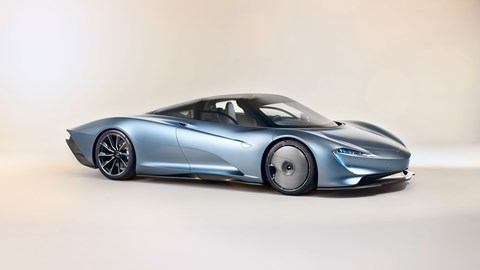
The front of the Speedtail looks like a squinting version of the usual McLaren ‘face’, as ducts and air intakes have been narrowed to reduce drag. Starting with the sculpted front splitter, McLaren has used all five metres of the car to fold, tuck and direct airflow on the path of least resistance.
Inlets at the front of the car ease air through the sides of the Speedtail, around wheel arches and through door vents. And even engine air-intakes – situated behind the glass canopy – melt gradually into the bodywork to stop airflow separating from the car’s surface.
The Speedtail lives up to its name at the rear, and features extended rear bodywork to improve aerodynamic efficiency even further. Unlike a more abrupt design, McLaren says the back of the Speedtail cleans up air flow and draggy turbulence, allowing for a higher top speed.
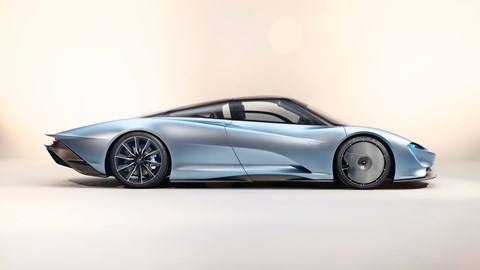
Underneath, rear blades smooth airflow either side of a large, lengthy diffuser, while on the top surface of the car, movable ailerons work to generate the optimum level of downforce at any given time. Interestingly, those ailerons don’t have seams either, and actually bend the flex the Speedtail’s carbonfibre bodywork. The result? No panel gaps means minimum air disruption.
McLaren Speedtail: tricks of the trade
McLaren engineers have used a handful of innovative techniques to reduce the weight and turbulence of the new Speedtail. At the front-axle, carbonfibre shrouds – reminiscent of 2009 F1 cars – cover the 20-inch, 10 spoke wheels, limiting the aero effect they cause – and the Speedtail borrows an idea off the forthcoming Audi e-Tron too.
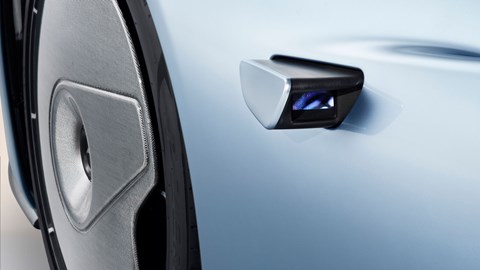
Just like Audi’s electric SUV, the McLaren Speedtail offers electric cameras instead of conventional door mirrors, reducing drag around the sides of the car. In Velocity mode – which also lowers the car by a 35mm to just 1120mm at its highest point – the cameras slot back into the car, reducing the aerodynamic wake of the Speedtail even more.
As you’d expect, the Speedtail uses carbonfibre monocoque and lighter 1K Titanium Deposition Carbonfibre body panels to weigh in at just 1430kg without fluids, but McLaren has shaved off the grams in more subtle ways, too: electrochromic glass darkens the top of the windscreen, removing the need for sun visors, and the same technology is applied to the upper section of the doors, the porthole and the rear rear-quarter lights. That’ll be worth about 300g at least, right?
McLaren is offering a bespoke luggage set to all 106 owners, that’ll match the spec of their chosen interior.
McLaren Speedtail: a fighter jet interior
The McLaren Speedtail may be the first ‘hyper GT car’ the Woking-based firm has ever made, but inside it borrows the ideas of the McLaren F1, and executes them with the switchgear and style you’d find in a contemporary McLaren. The much-mooted three-seat configuration is here, too – with the driver’s chair edged further forward, of course – and most of the car’s instrumentation is digital.
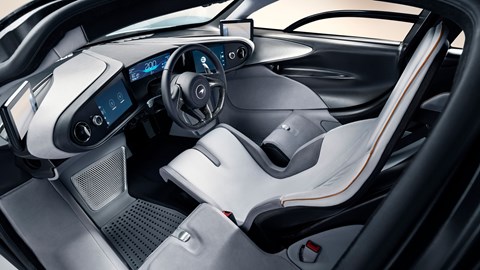
All the other switchgear is fashioned from polished aluminum, and the engine start button – as well as the switch for the car’s velocity mode – is found on the ceiling of the teardrop-shaped cockpit, above the driver’s head.
Among all the hand-stitched leather and bespoke materials, McLaren also introduced ‘directional’ leather that should allow occupants to easily slip into the car, but be gripped when actually driving.
Customising the beast
The car’s 106 customers are able to choose from three broad collections or looks – each containing at least three further variations. While every aspect of the car’s look can be easily personalised, McLaren thinks this theme and collection set-up will take much of the hassle out of ordering and speccing their new supercar.
The Urbane collection was supposed to offer a cool, sophisticated look to the new hypercar, with the Stratosphere theme (pictured above) a prime example of what McLaren called a ‘cool-hued look.’ The Visionary collection looks to be a little bolder, with one of the themes called Astral ‘inspired by the UK’s wealth of nautical heritage.’
Think lots of navy blue, orange and bits of silver – and you’re pretty much there. Oh, and a white gold, 18-carat badge.
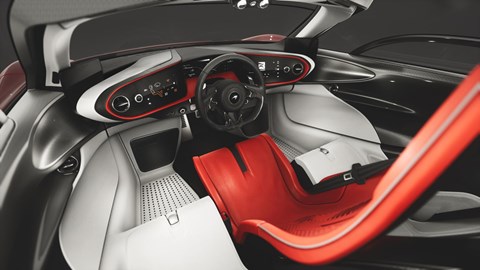
Dynamic appears to be the most showy, Instagram-friendly collection, and is probably best represented by the Bloodline theme. As you can tell from the name, it’s all bursts of red and gloss black with bits of copper and white thrown in – you can check the Bloodline interior above. We think our pick would be the Urbane collection.
Read more McLaren reviews